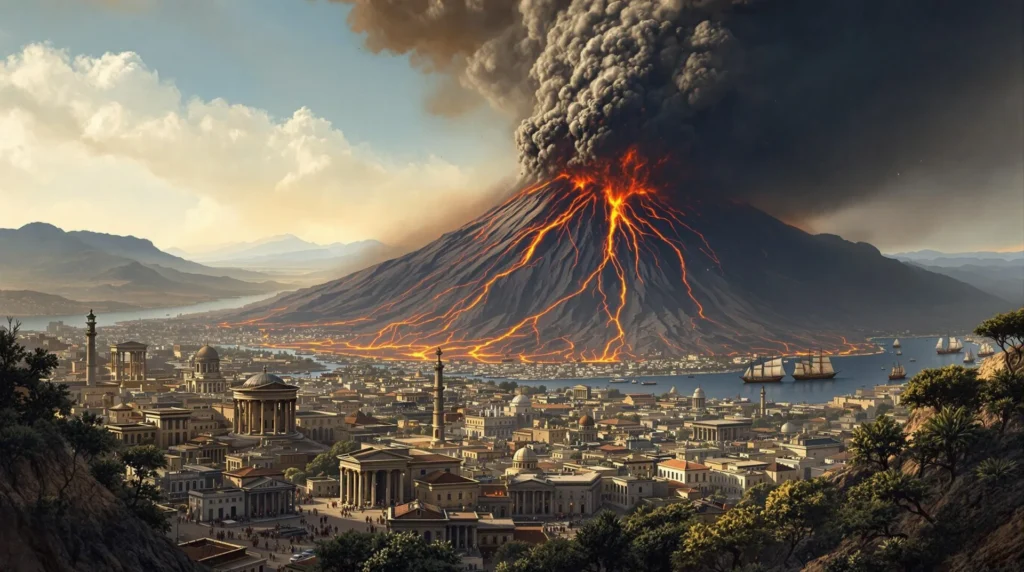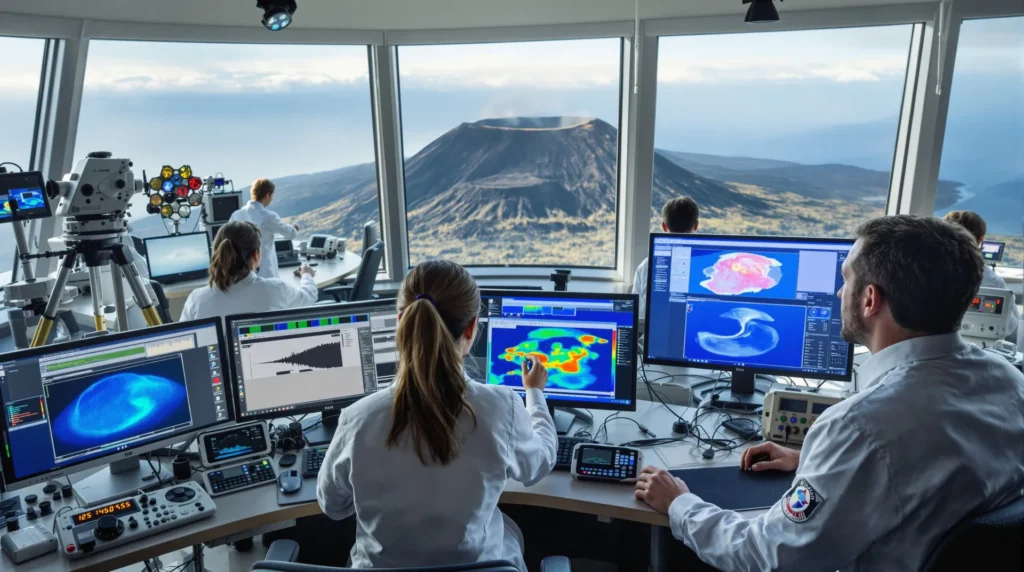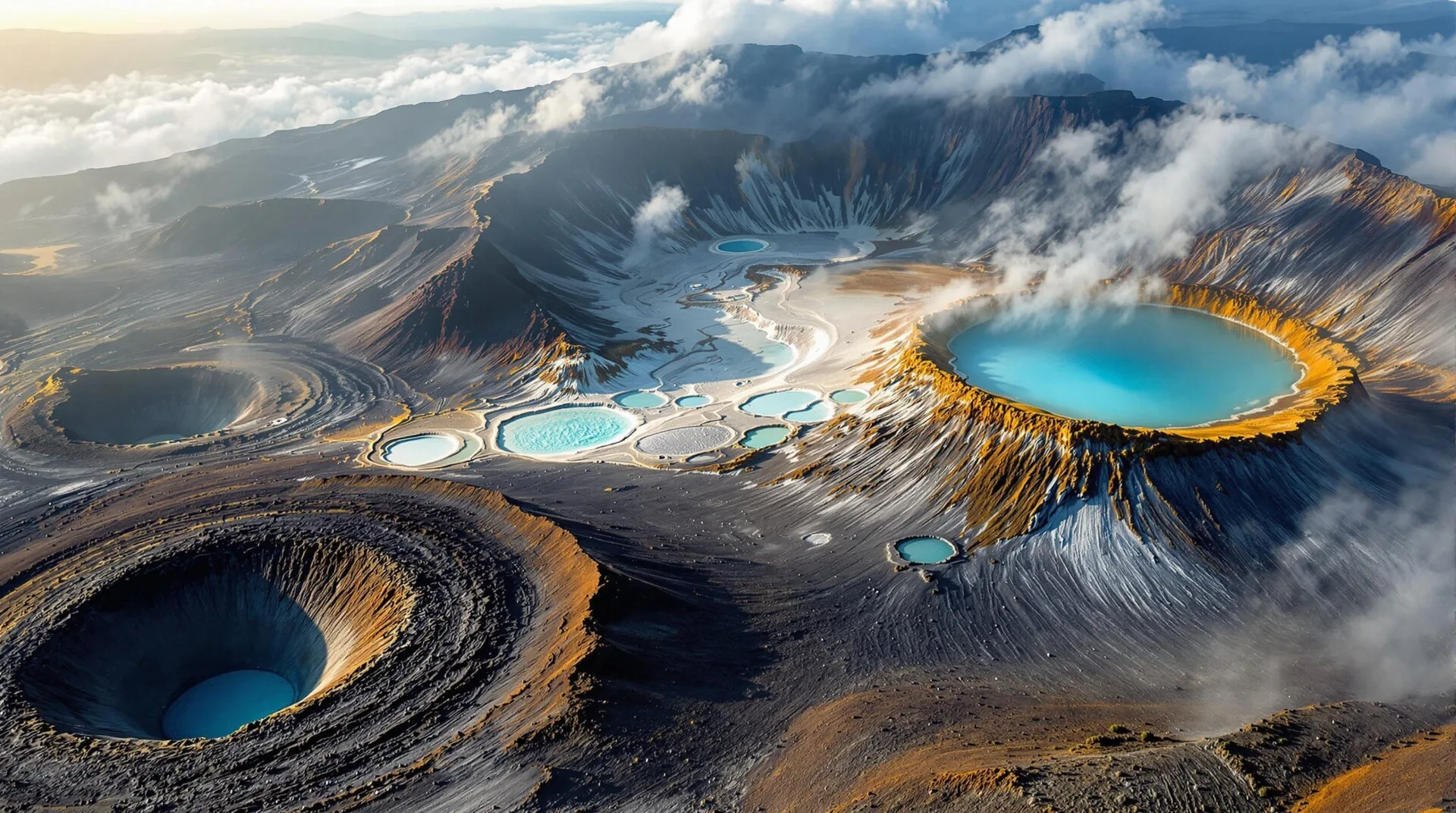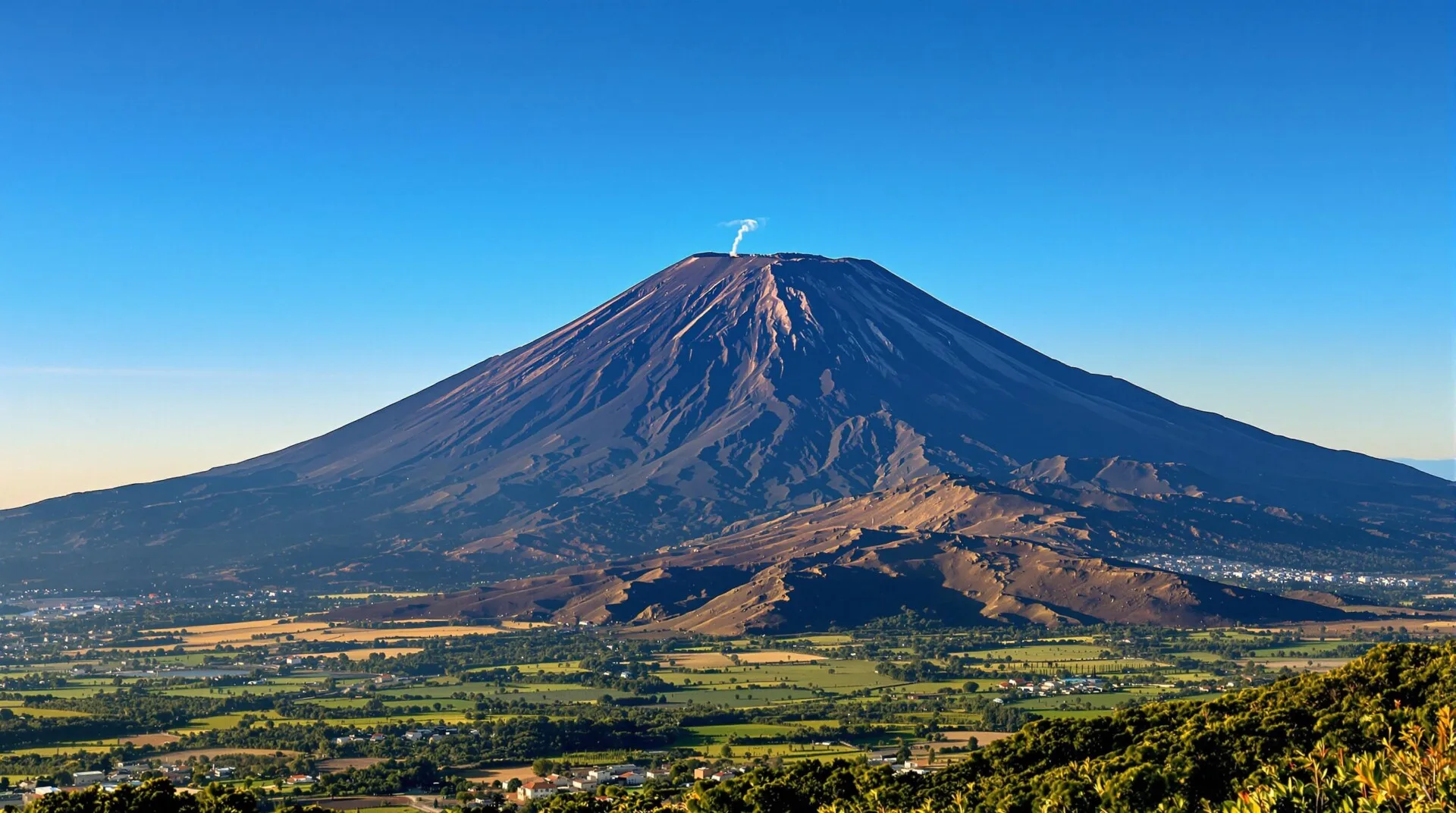Have you ever looked at a tall mountain and wondered about the stories it could tell? The Mount Vesuviuswhich stands proudly near the beautiful Bay of Naples in Italy, is one of those mountains. But it is not just any mountain; it is a volcánand a very famous one! You probably know him best for something quite dramatic: the burial of the ancient cities of Pompeii and Herculaneum. But believe me, there is much more to this incredible volcano than that one unforgettable event.
Today, let's dive deep into the world of Vesuvius. We'll look at the facts, the numbers, and all the interesting details that make it a fascinating story, both for the Earth itself and for us humans. It's amazing how much we can learn from a single volcano, from how the Earth's plates move to how people lived long ago.

Panoramic view of Mount Vesuvius over the Bay of Naples with modern Naples in the distance, clear blue sky.
The dramatic story of the eruptions of Mount Vesuvius
When you imagine a volcano, you might think of a perfect cone shape. Well, the Vesuvius is a little differentIt's like a volcano that has another volcano inside it.! Imagine those Russian dolls, but made of rock and fire.. There is an older and larger mountain called Monte Sommaand, within it, there is a younger and more active part called the Large Cone.
How does something like that happen? Think of a really, really huge eruption. It can be so powerful that the original volcano actually collapses in on itself, leaving a giant hole called the caldera. Over time, the volcano becomes active again and new stuff starts to accumulate inside that old hole. That's how you get this unique, two-stage volcano, like the Vesuvius. Great, isn't it?
This special structure also tells us a lot about the types of eruptions that can occur on the Vesuvius. It suggests that, over the course of its history, the Vesuvius has had some really bad rashes explosiveThe kind that can change the appearance of the earth in the blink of an eye. And when scientists look at evidence from past eruptions, this idea definitely holds up.

Cross section of Vesuvius showing the caldera of Monte Somma and the inner cone of the Great Cone.
The Catastrophic Eruption of 79 A.D.
Well, we can't talk about the Vesuvius not to mention the big one: the eruption of 79 A.D.. This is the one that most people think of when they hear the name of Vesuviusand for good reason. It was a truly terrible event that wiped out the Roman cities of Pompeii and Herculaneum. But even though it was a disaster, it also gave us an incredible amount of information about life in Roman times, like a snapshot of history frozen in time.
So what kind of power are we talking about here? Well, the first part of the eruption, called the Plinian phasesent a gigantic column of ash and pumice very high in the sky, as if it were a 📌 15 to 30 kilometers altitude.! To put that in perspective, airplanes usually fly at about 10 kilometers high. So this ash cloud was three to five times higher than that! It basically went through the stratosphere. For almost an entire day, the ash and pumice rained down on Pompeiiand finally they buried the city under almost 📌 3 meters Can you imagine that?
KEY FACT: The ash cloud from the 79 AD eruption reached an altitude of 15-30 km, significantly impacting the surrounding area.
And if you think that sounds bad, what happened to Herculaneum was even worse. Because it was closer to the volcano, it was hit by something called the pyroclastic flows. These are like super-hot avalanches made of gas, ash and rocks that rush down the volcano's slope super-fast. Imagine a scorching hurricane that is also unstoppable and deadly. Herculaneum ended up buried under a whopping 📌 23 meters of volcanic material! That's like being under a pile of earth as high as a seven story building. Temperatures were also crazy, over 📌 500 degrees Celsiushot enough to turn anything into steam! Scientists even found the brain of a young boy in the Herculaneum that had been turned to glass by the heat. It is a chilling reminder of the power that lies beneath the surface.

Dramatic eruption of Vesuvius in 79 A.D., ash cloud over Pompeii, pyroclastic flows towards Herculaneum, an ancient Roman site.
Significant eruptions beyond 79 AD.
It is very important to remember that the eruption of 79 A.D. was only one event in the long and fiery history of the Vesuvius. There have been many other significant eruptions, each with its own story to tell. The Vesuvius has definitely not been quiet for centuries!
Take, for example, the eruption of the 📌 472 AD.for example. The ash cloud from that one traveled an incredibly long distance, as far as Constantinoplewhich is now IstanbulThat's like over a thousand miles away! It really shows you how massive these eruptions can be. Then there was one in it 📌 512 A.D., was so serious that the king of the time, Theodoric the Greateven granted tax exemptions to people who lived near the VesuviusImagine getting a tax break because a volcano erupted! But it makes sense, doesn't it? These events would have completely disrupted daily life, probably even affecting important decisions. These were not just geological events; they had real consequences for people and the economy.
CURIOUS FACT: The eruption of Vesuvius in 472 A.D. sent ash as far as Constantinople (present-day Istanbul).
After a few quiet centuries, things became active again at 📌 1631. This eruption changed the rules of the game for the Vesuviuswhich led to more frequent activity. It caused much destruction, killing thousands of people. Lava flowed into the sea and ash blocked the sun for days. Basically, it began a period of almost constant volcanic activity. So it wasn't just one big explosion, but a series of smaller, but still dangerous eruptions. Even in the 20th century, the Vesuvius was noted. At 📌 1906There was a large eruption that produced a record amount of lava, even more than in 79 A.D.! You may not hear much about this one, but the amount of lava tells scientists how powerful an eruption it was. More lava means a larger area covered and longer lasting effects. This particular eruption was so strong that it even ruined Italy's plans to host the 📌 1908 Summer Olympic Games.. The Vesuvius has even impacted global events, that's pretty wild!
And then, just a few years later, in 📌 1944right in the middle of the Second World War, the Vesuvius A volcano erupted again! Can you believe it, a volcano erupting while a world war was being fought! It caused damage to nearby villages and even affected allied military operations in the area. It's like another level of chaos!

The eruption of Vesuvius in 1906, with extensive lava flows that reached populated areas.
Current Monitoring and Living Near Mount Vesuvius
Even with all this history of destruction, millions of people are still living near the Vesuvius today. It's a little scary, isn't it? Knowing that there's a volcano right there that could erupt at any moment.. There are about 📌 3 million people living close enough to be affected by a future eruption, and more than 📌 600,000 of them are located in what is called the ".red zone"the area of greatest risk. it's a lot of people!
So, what is being done to monitor the Vesuvius and protect everyone who lives nearby? Well, the good news is that Italy has an amazing volcanic observatory called the Vesuvius Observatory. And get this: it was founded in 📌 1841 y is the oldest volcano observatory in the world - that means they've been observing this volcano for almost 200 years! That's serious dedication!
These days, they use all kinds of high tech tools. Monitor the seismic activitywhich means they track earthquakes. They also measure whether the ground is changing shape, as if the volcano is changing shape. bulging. And they analyze the gases emanating from the volcano to see if there are changes in its composition.. It is as if they were constantly checking the volcano's vital signs.looking for any clues that could mean an eruption is approaching.. They even have a color-coded alert systemsimilar to the one used for hurricanes. Green means all is well, yellow means be alert and red means an eruption is occurring or about to occur.And now, they can even send emergency messages directly to people's phones! So no one can say that they did not receive the messageIt's like a special weather alert just for the volcano.!
Vesuvius Observatory: Established in 1841, it is the oldest volcanic observatory in the world, dedicated to the monitoring of Mount Vesuvius.
But we thought for a moment about the worst-case scenario. What if there is a major eruption? What is the plan to get all those people out of the red zone? Well, Italy has a national emergency plan. The idea is to evacuate everyone in the red zone within the 📌 72 hours after receiving a warning about an eruption. They have special routes to get people out, ways to transport them, and even places in other regions where people can go temporarily. It seems incredibly complicated to move so many people in such a short time. But Italian authorities are always working on it, learning from past eruptions to improve the plan and hopefully keep people safe. It's a reminder that, even with all our technology and planning, we still depend on the mercy of nature.

Scientists at the Vesuvius Observatory monitor the volcano with seismographs, gas analyzers and other modern equipment.
The Enduring Human Connection to Vesuvius
Living so close to a active volcano It makes you wonder, doesn't it, what it must be like to know that your home and your life could change in an instant? This brings us to another important part of the story: the human side. It's not just about rocks and ash; it's about the people who have lived and still live right next to this powerful force of nature. Their stories are as interesting as the volcano itself. They show us how strong and adaptable humans can be, and the special relationship we have with nature. It's amazing to think of how many people choose to live in this area with the Vesuvius right there. You have to ask yourself how it has shaped their lives, their culture and even their identity.
The connection between the Vesuvius and people go back to the ancient Romans. They didn't just see it as a mountain; it was practically a god to them! They linked it to Vulcanotheir god of fire. And there were all kinds of stories about heroes such as Hercules that passed through the land of fire. It is amazing how they wove these myths and beliefs into their understanding of the world around them. And this connection has continued throughout the centuries. Think of all the paintings and books it has inspired. From dramatic landscapes painted in the eighteenth century to poems and even modern movies and novels, the Vesuvius really captures our imagination. She is like a muse, but also a threat. It can inspire so much beauty, but also so much fear.
Speaking of which, the Vesuvius is now a major tourist attraction. People from all over the world come to climb to the top and look into the crater. It's almost like a special trip to see this iconic force of nature. And it's hard to describe what it feels like to stand on the edge of that crater, looking out over the Bay of Naples, knowing that there is an incredible power right below you. It makes you feel small and reminds you of the raw energy that shapes our planet. It's something you really have to experience yourself to truly understand. There is a palpable energy there, as if the volcano is holding its breath, and you can't help but wonder when it will "exhale" again.

Tourists walking along a trail ascending Vesuvius, with the volcanic crater visible and the Bay of Naples in the background.
Conclusion
So, what have we learned from this journey into the world of the Mount Vesuvius? For me, it's a story full of contrasts: strength and vulnerability, creation and destruction. It shows us how adaptable humans can be, from the ancient Romans who rebuilt their lives after the disaster of 79 A.D. to the scientists who are working hard to protect people today. But it also reminds us that, ultimately, we are at the mercy of nature. Even with all our technology and plans, one eruption could change everything.
Perhaps the most important thing to remember is that we need to respect this power. We need to learn from the past, prepare for the future and find ways to live alongside these amazing but potentially dangerous forces. But the Vesuvius is still there, watching over the lives of everyone who lives nearby. It is a constant reminder that our planet is alive and ever-changing, and that we are all part of this great interconnected system. It's a humbling thought, and perhaps one we should all think about a little more often.









